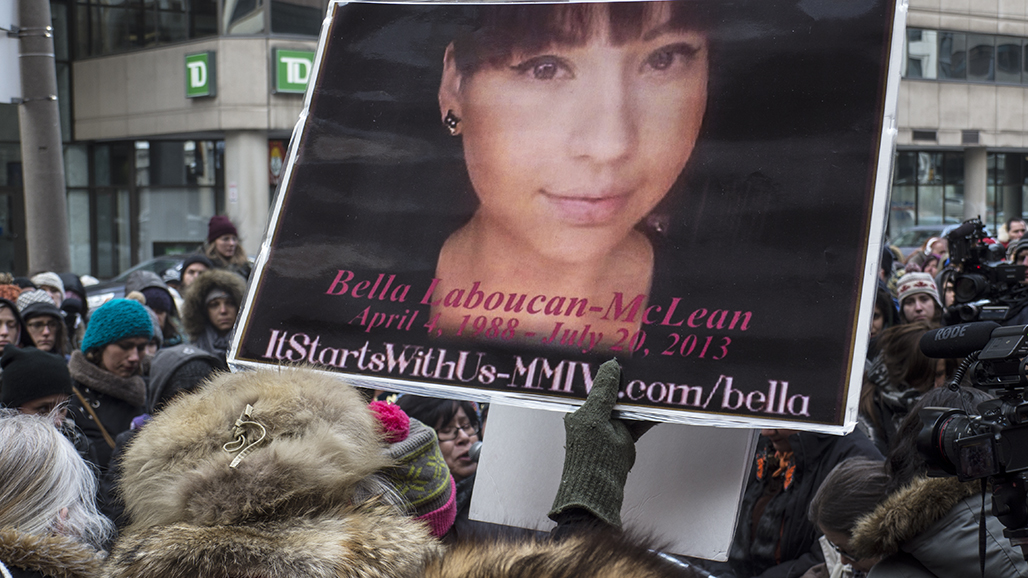Like this article? Chip in to keep stories likes these coming.
This year marks the 25th anniversary of the Women’s Memorial Day March in Vancouver. This event exists to commemorate the lives of women who have gone missing or were murdered in Vancouver’s Downtown Eastside (DTES). In recent years the issue of Missing and Murdered Indigenous Women has begun to gain more attention from the Canadian public, international community and authorities. Yet the problem persists.
Angela MacDougall, Executive-Director of Battered Women Support Services in Vancouver, had this to say about the march: “What is unprecedented now is that on February 14 there is a national movement and it has grown extraordinarily in recent years. We marched for 15-20 years before people even caught wind of the Memorial March and now it’s in 25 cities.”
MacDougall began attending the march in 1994.
“There were many women [who had] gone missing and it became apparent that there was a problem. The march was the only place at that time where anyone was talking about missing and murdered women in the DTES of Vancouver. It was a place to grieve, mourn the loss of the women I knew, honour women. It was a place to take to the streets, and take space,” she said.
The march continues to be a space for remembrance.
“This is the work the work of all of us and it doesn’t matter which one that you attend, but we should all attend wherever we are,” said Lee Maracle, author and educator at the University of Toronto. “I have relatives that have died. One of them is named Dawn Crey and she is never going to get justice, she was the one who was found at the Pickton farm. They found her DNA, but not her body.”
This type of personal trauma which is faced by Aboriginal women gained national attention this November when a young First Nations teenager Rinelle Harper lived to tell of her experience after she was brutally attacked near the Assiniboine River. She addressed the Assembly of First Nations meeting in Winnipeg publicly asking for a national inquiry into MMIW.
No inquiry has been set, but on February 27, 2015 a National Roundtable will occur between families of the Missing and Murdered Indigenous Women, Federal Ministers, and the Assembly of First Nations. The focus is on achieving tangible outcomes in a number of areas: prevention and awareness; community safety plans and protocols; policing measures; and, justice responses. The objective is to build a national dialogue addressing and ending violence against Indigenous women with the hopes of securing a National Inquiry.
Dawn Harvard, the Interim-President of the Native Women’s Association of Canada, had this to say about the Roundtable:
“Our demands, pleas for a national inquiry have been falling on deaf ears federally, they have been stonewalling on this particular issue. We had the support from all the provinces and territories to begin to dialogue but it was not happening. So we said let’s at least have this roundtable to get the federal government to come to the table for this strategy. What is Canada if not just the sum of provinces and territories who are saying we need action on this and that the pressure would be there for the federal government to start this meaningful dialogue.”
The Federal government supports the issue of violence through an Action Plan to Address Family Violence and Violent Crimes Against Aboriginal Women and Girls. This $25 million initiative over five years beginning in 2015/2016 aims to to prevent violence, support victims, and protect Aboriginal women and girls. Some of the types of projects supported through this action plan include funding of shelters on reserve, supporting the creation of DNA-based Missing Persons Index, and continuing support for police investigations through the National Centre for Missing Persons and Unidentified Remains.
“If you look at the trends that the rapes of the violent crimes, serious severe violence have actually declined for women in general, whereas for aboriginal women they have remained the same, or increased. The national action plan is out there to end violence, but it has not been in anyway been effective because it has not had an impact on the rates of the violence of our women,” said Harvard of the Action Plan.
In November 2014, Prime Minister Harper infamously said, “It’s very clear that there has been very fulsome study of this particular … of these particular things. They’re not all one phenomenon.”
Countless studies are penned by Canadian and international organizations. The most recent investigation into the issue was conducted by the Inter-American Commission on Human Rights and released in early 2015. The Commission’s investigation focused on British Columbia and found that “the disappearances and murders of indigenous women in Canada are part of a broader pattern of violence and discrimination against women in Canada.” It makes a number of recommendations based on its investigation.
Notable recommendations are that, “Addressing violence against women is not sufficient unless the underlying factors of discrimination that originate and exacerbate the violence are also comprehensively addressed.”
The report also calls for strong support for the creation of a national-level action plan or a nation-wide inquiry into the issue in order to better understand and address the problem.
Clearly this issue isn’t going away any time soon, but calls for an inquiry and government action will continue as it persists.
Christina Gray holds a Juris Doctor and Art History degree from the University of British Columbia. She is a proud member of Lax Kw’alaams Tsimshian Band, and is also of Dene, and Metis descent.
Photo: Elizabeth Littlejohn
Like this article? Chip in to keep stories likes these coming.



